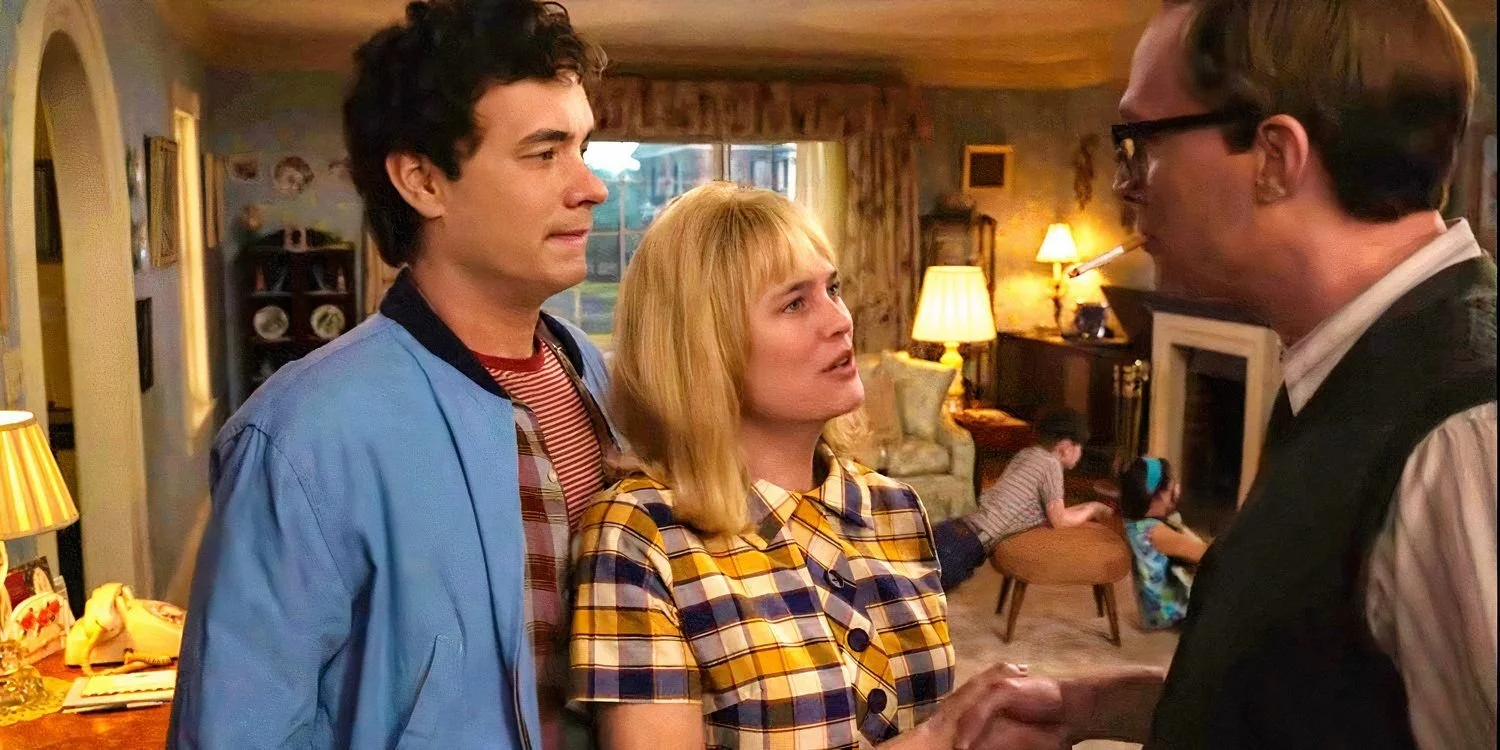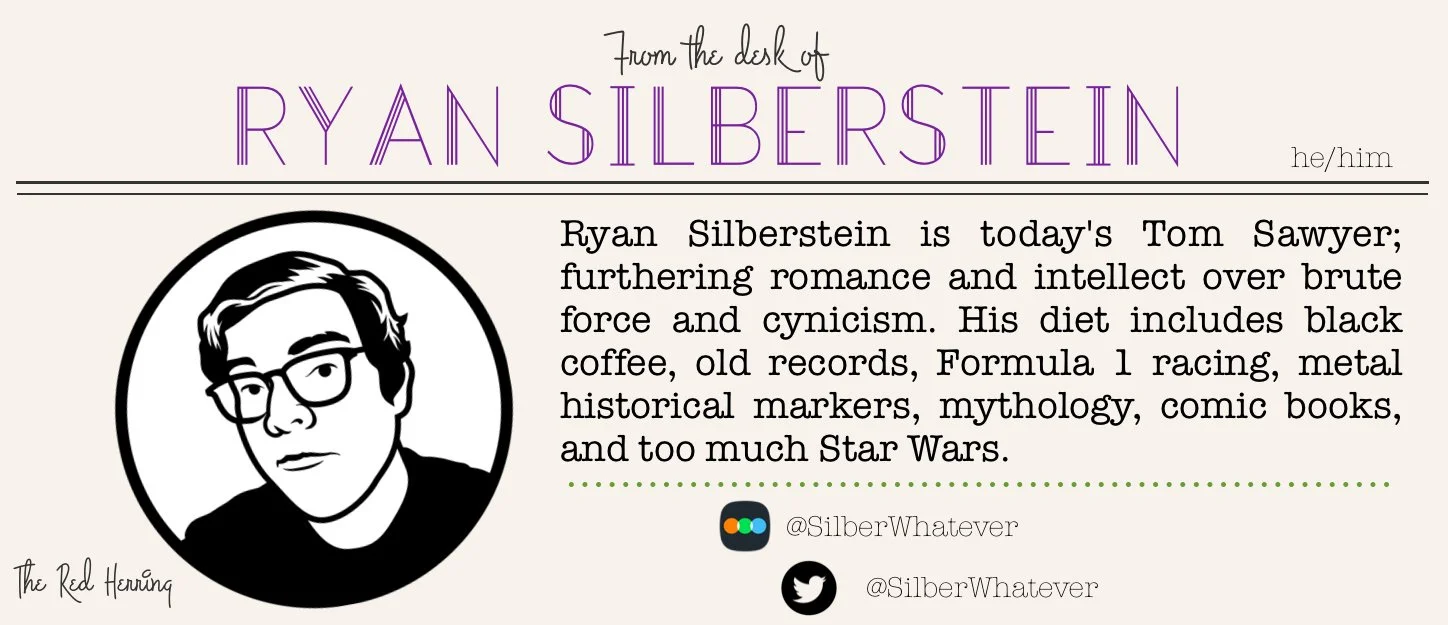HERE takes a big swing, but its understanding of America is out of touch
Here
Directed by Robert Zemeckis
Written by Eric Roth, Robert Zemeckis
Starring Tom Hanks, Robin Wright, Paul Bettany, Kelly Reilly
Rated PG-13
Runtime: 1 hour, 44 minutes
In theaters November 1
by Ryan Silberstein, Managing Editor, Red Herring
It would be accurate to call Here a gimmick movie, as the film is essentially one static shot of the same place over the course of Earth’s history through the present–with a heavy emphasis on the residents of a house built on the spot in the early 20th century. Watching it has a similar effect to that of an art piece or a theme park experience, a non-linear timelapse giving a glimpse into the lives of middle-class northeasterners over the last 100 years. This limited view of history is intentional, but the execution highlights the numerous shortcomings of Baby Boomer worldviews.
There’s a lot to unpack here, so, in the name of orientation, Here mainly traces the lives of World War II veteran Al (Paul Bettany) and his wife Rose (Kelly Reilly), their son Richard (Tom Hanks, from aged 18 onward), and his wife Margaret (Robin Wright). We see glimpses of other residents of this land over the course of the film’s mostly non-linear presentation, including Native Americans who lived there before colonization, Benjamin Franklin’s Loyalist son William (Daniel Betts), a turn of the century aviation enthusiast (Gwilym Lee) and his stuck-up wife (Michelle Dockery), a Bohemian inventor (David Fynn) and his flapper wife (Opehlia Lovibond), and, most recently, a contemporary Black family. These glimpses are transitioned between by using frames within the frame, a white border will materialize and bleed visual and/or audio across time periods.
What Here is grasping at is a new unifying American mythology. Ever since the 2000 election, there has been a growing binary ideological divide in the United States, and the identity of the country has rarely seemed more fraught (we did have a Civil War, but this is not addressed in Here). Both left and right have been preoccupied with “identity politics,” where the reconciliation between personal identity and national identity becomes harder to reconcile. How can Tea Party supporters and Trump loyalists reconcile Emma Lazaurus’ “The New Colossus” with white nationalism (they can’t)? They must demonize those on the left, progressives who are attempting to extend the promise of American life to those with differing ethnic, cultural, and gender identities while trying to expand economic equity. In reality, the right has hijacked patriotism as a way to disguise the hatred and enmity used as a bludgeon to advance the transfer of wealth from the middle class to those wealthy dragons that hoard our resources. All of this to say that Here is an interesting project for the 2020s, especially on the eve of another presidential election.
Here makes no references to partisanship or ideology but does not stay away from issues and attitudes on the minds of its characters. But because it is so gentle in tone–you could show this to a class of elementary school students if you were prepared with annotations to give context to the historical events and media they would not be aware of–that it undercuts its own argument. One of Here’s two primary sins is this gentlewashing of American history. By its northeast setting, screenwriter Eric Roth and director Robert Zemeckis feel they can include the American Revolution but skip over any representation of slavery or race, save a late scene where a Black father (Nicholas Pinnock) talks his son (Cache Vanderpuye) through how to act if traffic stopped by a cop. Native American characters only appear in the timeline before the arrival of colonists and never again after, reduced to people of the distant past rather than a people who continue to live in America. Also ignored are immigrants (from anywhere), queer folks, or any direct mention of class. These omissions feel massive in the wake of everything that has been discussed for the last 30 years in our culture.
The closest analogue to Here is Walt Disney’s Carousel of Progress, which was created for the 1964 World’s Fair as a partnership with General Electric. The attraction revolves around four scenes showing American life in 1900, 1920, 1940, and the future, with the same white, middle-class nuclear family discussing all of the technological innovations of the day. Shaped by Walt Disney himself and GE, it is not surprising that the story told within omits so much of the American story. But it feels like Zemeckis and Roth have not broadened their own perceptions of the country, 60 years later. Both men were fully adults when the show debuted, and it seems they may be stuck in that mindset.
I acknowledge that it would be silly to expect a feature film (or theme park attraction) with a relatively short runtime to explore all of these issues, but to leave out all of them only reinforces the version of American history taught in schools for much of the last century. In my elementary and middle-grade education in the 1990s, stories about women, minorities, and other groups were in our history textbooks but separated out into easily skippable chapters or sidebars (and people wonder why so many of us think Eli Whitney was Black). This view of history is centered on the Important Americans–the straight, white, male ones–and there is even only one woman in the film who is shown to be more than a wife and/or mother: Richard and Margaret’s daughter, Vanessa (played by multiple actresses, the eldest of whom is Zsa Zsa Zemeckis), becomes a very successful lawyer but rarely appears on screen once she leaves for college. A much better example of an attempt at a corrective is Jill Lepore’s stellar one-volume history of the United States, These Truths, published in 2018. While that book is almost a thousand pages, taking inspiration from a more inclusive American history would have made for a far more meaningful and noteworthy final product.
While Here is extremely frustrating for all of the reasons noted above, it is also frustrating because so much of what is here is quite good. Because of my affinity for the Carousel of Progress (my Disney history podcast–returning in 2025!–takes its name, Dream With Mind and Heart, from the attraction’s theme song lyrics) or American history in general, I likely fall to an extremely niche audience for this film. I absolutely loved significant aspects of the film. The playful approach to history and the attempt to show all of these stories crisscrossing one spot of land over time were fully enchanting. While it would be easy to dismiss this film as nothing but schmaltzy–like many do with the Carousel of Progress–there is an earnestness that shines through. Meeting the film where it is feels like too big of an ask for many different kinds of people, but the experimental nature combined with its warmth charmed me.
There are moments throughout Here that shine, and it is impressive how well-realized many of the characters are, even with limited time on screen. Each character feels like a distinct person and not merely an archetype. Leo and Stella, the inventor and flapper couple, stand out from the ensemble because they feel like characters we don’t see on screen. They are a childless couple (rarer a century ago than at present), and over the decades we follow their story, always appear to support each other as well as continue to be in love with each other, including an active sex life–sex is thankfully not lacking in this film.
The best performance, however, is given by Paul Bettany as Al Young. Al’s story begins when he and his wife Rose decide to buy the house in 1945. They have help from the G.I. bills, and Al struggles with hearing loss from the war and shrapnel in his hip. As they decide to buy the house, Rose raises her voice to tell him she is pregnant, something echoed much later when Richard contends with his father’s hearing loss due to old age. Al’s reliance on/struggle with alcohol is a recurring leitmotif in his life. Being undervalued in the economy is something both father and son struggle with, and the bitterness this breeds in men surfaces in heartbreaking ways in their lives.
Here is teasingly close to being an important piece of art about America. Sadly, it retreads the same unexamined point of view that elevated Christopher Columbus, Thomas Jefferson, and Woodrow Wilson to “national hero” status without considering how they are viewed by non-white people. America–and who/what is included in our history–is in a precarious position, and Here retreats back into comfort rather than making a bold choice. It’s a real shame, especially given that Zemeckis is part of the elite class of filmmakers that can get the budget to do anything he wants, and he again chooses to play it extremely safe with the stories he tells, rather than pushing forward new stories as well as the technology that so captivates him.



